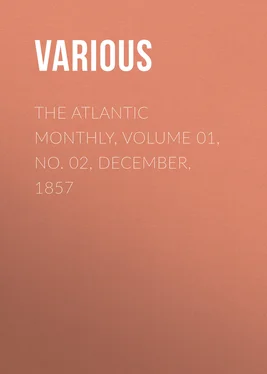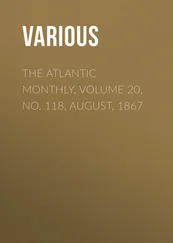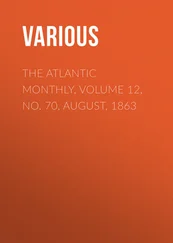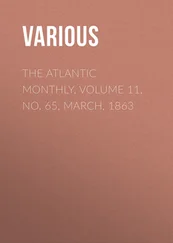Various - The Atlantic Monthly, Volume 01, No. 02, December, 1857
Здесь есть возможность читать онлайн «Various - The Atlantic Monthly, Volume 01, No. 02, December, 1857» — ознакомительный отрывок электронной книги совершенно бесплатно, а после прочтения отрывка купить полную версию. В некоторых случаях можно слушать аудио, скачать через торрент в формате fb2 и присутствует краткое содержание. Жанр: foreign_antique, periodic, foreign_edu, на английском языке. Описание произведения, (предисловие) а так же отзывы посетителей доступны на портале библиотеки ЛибКат.
- Название:The Atlantic Monthly, Volume 01, No. 02, December, 1857
- Автор:
- Жанр:
- Год:неизвестен
- ISBN:нет данных
- Рейтинг книги:3 / 5. Голосов: 1
-
Избранное:Добавить в избранное
- Отзывы:
-
Ваша оценка:
- 60
- 1
- 2
- 3
- 4
- 5
The Atlantic Monthly, Volume 01, No. 02, December, 1857: краткое содержание, описание и аннотация
Предлагаем к чтению аннотацию, описание, краткое содержание или предисловие (зависит от того, что написал сам автор книги «The Atlantic Monthly, Volume 01, No. 02, December, 1857»). Если вы не нашли необходимую информацию о книге — напишите в комментариях, мы постараемся отыскать её.
The Atlantic Monthly, Volume 01, No. 02, December, 1857 — читать онлайн ознакомительный отрывок
Ниже представлен текст книги, разбитый по страницам. Система сохранения места последней прочитанной страницы, позволяет с удобством читать онлайн бесплатно книгу «The Atlantic Monthly, Volume 01, No. 02, December, 1857», без необходимости каждый раз заново искать на чём Вы остановились. Поставьте закладку, и сможете в любой момент перейти на страницу, на которой закончили чтение.
Интервал:
Закладка:
It is singular, too, with what comparatively small means the Medici were enabled to do such great things. Cosmo, unquestionably the greatest and most successful citizen that ever lived,—for he almost rivalled Pericles in position, if not in talent, while he surpassed him in good fortune,—was, during his lifetime, the virtual sovereign of the most enlightened and wealthy and powerful republic that had existed in modern times. He built the church of San Marco, the church of San Lorenzo, the cloister of San Verdiano. On the hill of Fiesole he erected a church and a convent. At Jerusalem he built a church and a hospital for pilgrims. All this was for religion, the republic, and the world. For himself he constructed four splendid villas, at Careggi, Fiesole, Caffaggiolo, and Trebbio, and in the city the magnificent palace in the Via Larga, now called the Riccardi.
In thirty-seven years, from 1434 to 1471, he and his successors expended eight millions of francs (663,755 gold florins) in buildings and charities,—a sum which may be represented by as many, or, as some would reckon, twice as many, dollars at the present day. Nevertheless, the income of Cosmo was never more than 600,000 francs, (50,000 gold florins,) while his fortune was never thought to exceed three millions of francs, or six hundred thousand dollars. Being invested in commerce, his property yielded, and ought to have yielded, an income of twenty per cent . Nevertheless, an inventory made in 1469 showed, that, after twenty-nine years, he left to his son Pietro a fortune but just about equal in amount to that which he had himself received from his father.
With six hundred thousand dollars for his whole capital, then, Cosmo was able to play his magnificent part in the world's history; while the Duke of Milan, son of the peasant Sforza, sometimes expended more than that sum in a single year. So much difference was there between the position and requirements of an educated and opulent first-citizen, and a low-born military parvenu , whom, however, Cosmo was most earnest to encourage and to strengthen in his designs against the liberties of Lombardy.
This Riccardi palace, as Cosmo observed after his poor son Peter had become bed-ridden with the gout, was a marvellously large mansion for so small a family as one old man and one cripple. It is chiefly interesting, now, for the frescos with which Benozzo Gozzoli has adorned the chapel. The same cause which has preserved these beautiful paintings so fresh, four centuries long, has unfortunately always prevented their being seen to any advantage. The absence of light, which has kept the colors from fading, is most provoking, when one wishes to admire the works of a great master, whose productions are so rare.
Gozzoli, who lived and worked through the middle of the fifteenth century, is chiefly known by his large and graceful compositions in the Pisan Campo Santo. These masterpieces are fast crumbling into mildewed rubbish. He had as much vigor and audacity as Ghirlandaio, with more grace and freshness of invention. He has, however, nothing of his dramatic power. His genius is rather idyllic and romantic. Although some of the figures in these Medici palace frescos are thought to be family portraits, still they hardly seem very lifelike. The subjects selected are a Nativity, and an Adoration of the Magi. In the neighborhood of the window is a choir of angels singing Hosanna, full of freshness and vernal grace. The long procession of kings riding to pay their homage, "with tedious pomp and rich retinue long," has given the artist an opportunity of exhibiting more power in perspective and fore-shortening than one could expect at that epoch. There are mules and horses, caparisoned and bedizened; some led by grinning blackamoors, others ridden by showy kings, effulgent in brocade, glittering spurs, and gleaming cuirasses. Here are horsemen travelling straight towards the spectator,—there, a group, in an exactly opposite direction, is forcing its way into the picture,—while hunters with hound and horn are pursuing the stag on the neighboring hills, and idle spectators stand around, gaping and dazzled; all drawn with a free and accurate pencil, and colored with much brilliancy;—a triumphant and masterly composition, hidden in a dark corner of what has now become a great dusty building, filled with public offices.
XI. FIESOLE
Here sits on her hill the weird old Etrurian nurse of Florence, withered, superannuated, feeble, warming her palsied limbs in the sun, and looking vacantly down upon the beautiful child whose cradle she rocked. Fiesole is perhaps the oldest Italian city. The inhabitants of middle and lower Italy were Pelasgians by origin, like the earlier races of Greece. The Etrurians were an aboriginal stock,—that is to say, as far as anything can be definitely stated regarding their original establishment in the peninsula; for they, too, doubtless came, at some remote epoch, from beyond the Altai mountains.
In their arts they seem to have been original,—at least, until at a later period they began to imitate the culture of Greece. They were the only ancient Italian people who had the art-capacity; and they supplied the wants of royal Rome, just as Greece afterwards supplied the republic and the empire with the far more elevated creations of her plastic genius.
The great works undertaken by the Tarquins, if there ever were Tarquins, were in the hands of Etrurian architects and sculptors. The admirable system of subterranean drainage in Rome, by which the swampy hollows among the seven hills were converted into stately streets, and the stupendous cloaca maxima , the buried arches of which have sustained for more than two thousand years, without flinching, the weight of superincumbent Rome, were Etrurian performances, commenced six centuries before Christ.
It would appear that this people had rather a tendency to the useful, than to the beautiful. Unable to assimilate the elements of beauty and grace furnished by more genial races, this mystic and vanished nation was rather prone to the stupendously and minutely practical, than devoted to the beautiful for its own sake.
At Fiesole, the vast Cyclopean walls, still fixed and firm as the everlasting hills, in their parallelopipedal layers, attest the grandeur of the ancient city. Here are walls built, probably, before the foundation of Rome, and yet steadfast as the Apennines. There are also a broken ring or two of an amphitheatre; for the Etrurians preceded and instructed the Romans in gladiatorial shows. It is suggestive to seat one's self upon these solid granite seats, where twenty-five hundred years ago some grave Etrurian citizen, wrapped in his mantle of Tyrrhenian purple, his straight-nosed wife at his side, with serpent bracelet and enamelled brooch, and a hopeful family clustering playfully at their knees, looked placidly on, while slaves were baiting and butchering each other in the arena below.
The Duomo is an edifice of the Romanesque period, and contains some masterpieces by Mino da Fiesole. On a fine day, however, the church is too dismal, and the scene outside too glowing and golden, to permit any compromise between nature and Mino. The view from the Franciscan convent upon the brow of the hill, site of the ancient acropolis, is on the whole the very best which can be obtained of Florence and the Val d' Arno. All the verdurous, gently rolling hills which are heaped about Firenze la bella are visible at once. There, stretched languidly upon those piles of velvet cushions, reposes the luxurious, jewelled, tiara-crowned city, like Cleopatra on her couch. Nothing, save an Oriental or Italian city on the sea-coast, can present a more beautiful picture. The hills are tossed about so softly, the sunshine comes down in its golden shower so voluptuously, the yellow Arno moves along its channel so noiselessly, the chains of villages, villas, convents, and palaces are strung together with such a profuse and careless grace, wreathing themselves from hill to hill, and around every coigne of vantage, the forests of olive and the festoons of vine are so poetical and suggestive, that we wonder not that civilized man has found this an attractive abode for twenty-five centuries.
Читать дальшеИнтервал:
Закладка:
Похожие книги на «The Atlantic Monthly, Volume 01, No. 02, December, 1857»
Представляем Вашему вниманию похожие книги на «The Atlantic Monthly, Volume 01, No. 02, December, 1857» списком для выбора. Мы отобрали схожую по названию и смыслу литературу в надежде предоставить читателям больше вариантов отыскать новые, интересные, ещё непрочитанные произведения.
Обсуждение, отзывы о книге «The Atlantic Monthly, Volume 01, No. 02, December, 1857» и просто собственные мнения читателей. Оставьте ваши комментарии, напишите, что Вы думаете о произведении, его смысле или главных героях. Укажите что конкретно понравилось, а что нет, и почему Вы так считаете.












